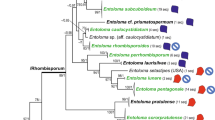Abstract
Taxonomic misidentification has potentially serious consequences for the management of threatened species. Closely related moss species are often difficult to distinguish from each other using morphological characteristics. Here we compared the use of molecular (DNA barcoding of the trnL-F intron, AFLPs) and morphological techniques to demonstrate that ex situ cultures, held for re-introduction trails, of the UK critically endangered moss Orthodontium gracile were contaminated with the potentially invasive species O. lineare. Barcoding techniques and AFLPs were both successful in determining Orthodontium species identity. There was some discrepancy between determinations from molecular and morphological techniques and some individuals were misidentified using morphological characteristics alone. When species identity is critical, for example prior to re-establishment or re-introduction programmes, we recommend that identity of mosses and other bryophytes be established by molecular techniques, in particular barcoding of the trnL-F intron.





Similar content being viewed by others
References
Blockeel TL, Long DG (1998) A check-list and census catalogue of British and Irish bryophytes. British Bryological Society, Cardiff
Burch J (2003) A pilot study for the ex situ conservation of bryophytes. August 2000–July 2003. Final report. RBG Kew
Church JM, Hodgetts NG, Preston CD et al (2001) British red data books—mosses and liverworts. JNCC, Peterborough
Cowan RS, Chase MW, Kress WJ et al (2006) 300, 000 species to identify: problems, progress, and prospects in DNA barcoding of land plants. Taxon 55:611–616
Cox CJ, Hedderson TAJ (1999) Phylogenetic relationships among the ciliate arthrodontous mosses: evidence from chloroplast and nuclear DNA sequences. Plant Syst Evol 215:119–139. doi:10.1007/BF00984651
Doyle JJ, Doyle JL (1987) A rapid DNA isolation procedure for small quantities of fresh leaf tissue. Phytochem Bull Bot Soc Am 19:11–15
Duckett JG, Goode JA, Matcham HW (2001) Studies of protonemal morphogenesis in mosses. VIII. The gemmiferous protonemata of orthodontium and dicranoweisia. J Bryol 23:181–193
ECCB (1995) Red data book of European bryophytes. European committee for the conservation of bryophytes
Ford CS, Ayres KL, Toomey N et al. (2009) Selection of candidate coding DNA barcoding regions for use on land plants. Bot J Linn Soc (in press)
Hassel K, Sastad SM, Gunnarsson U et al (2005) Genetic variation and structure in the expanding moss Pogonatum dentatum (Polytrichaceae) in its area of origin and in a recently colonized area. Am J Bot 92:1684–1690
Hebert PDN, Ratnasingham S, deWaard JR (2003) Barcoding animal life: cytochrome c oxidase subunit 1 divergences among closely related species. Proc R Soc Lond Ser B-Biol Sci 270:S96–S99. doi:10.1098/rsbl.2003.0025
Hedenas L, Herben T, Rydin H et al (1989) Ecology of the invading moss species Orthodontium lineare in Sweden—substrate preference and interactions with other species. J Bryol 15:565–581
Herben T (1994) Local-rate of spreading and patch dynamics of an invasive moss species, Orthodontium lineare. J Bryol 18:115–125
Hill MO, Preston CD, Smith AJE (eds) (1994) Atlas of the bryophytes of Britain and Ireland. Vol 3. Mosses (Diplolepideae). Harley Books, Colchester
IUCN (1998) IUCN guidelines for re-introductions. IUCN, Gland
Long DG, Paton JA, Squirrell J et al (2006) Morphological, ecological and genetic evidence for distinguishing Anastrophyllum joergensenii Schiffn. and A. alpinum Steph. (Jungermanniopsida : Lophoziaceae). J Bryol 28:108–117
Meijer W (1952) The genus Orthodontium. Acta Bot Neerl 1:3–80
Metcalf JL, Pritchard VL, Silvestri SM et al (2007) Across the great divide: genetic forensics reveals misidentification of endangered cutthroat trout populations. Mol Ecol 16:4445–4454. doi:10.1111/j.1365-294X.2007.03472.x
O’Hanlon PC, Peakall R (2000) A simple method for the detection of size homoplasy among amplified fragment length polymorphism fragments. Mol Ecol 9:815–816. doi:10.1046/j.1365-294x.2000.00924.x
Tropicos.org Missouri_Botanical_Garden (2008) http://www.tropicos.org/NameSearch.aspx?name=orthodontium&commonname=. Accessed 23–24/09/08
Porley RD (1998) Using nerve sections to separate Orthodontium gracile Schwaegr. ex Br. Eur. and O. lineare Schwaegr. J Bryol 20:500–501
Porley RD, Matcham HW (2003) The status of Orthodontium gracile in Britain and Ireland. J Bryol 25:64–66. doi:10.1179/037366803125002680
Rowntree JK (2006) Development of novel methods for the initiation of in vitro bryophyte cultures for conservation. Plant Cell Tissue Organ Cult 87:191–201. doi:10.1007/s11240-006-9154-7
Rowntree JK, Ramsay MM (2005) Ex situ conservation of bryophytes: progress and potential of a pilot project. Bol Soc Esp Briol 26–27:17–22
Savolainen V, Cowan RS, Vogler AP et al (2005) Towards writing the encyclopaedia of life: an introduction to DNA barcoding. Philos Trans R Soc B-Biol Sci 360:1805–1811. doi:10.1098/rstb.2005.1730
Skotnicki ML, Mackenzie AM, Clements MA et al (2005) DNA sequencing and genetic diversity of the 18S–26S nuclear ribosomal internal transcribed spacers (ITS) in nine Antarctic moss species. Antarct Sci 17:377–384. doi:10.1017/S0954102005002816
Smith AJE (2004) The moss flora of Britain & Ireland. Cambridge University Press, Cambridge
Stieperaere H, Jacques E (1995) The spread of Orthodontium lineare and Campylopus introflexus in Belgium. Belg J Bot 128:117–123
Swofford DL (1998) PAUP*: phylogenetic analysis using parsimony (*and other methods) V4. Sinauer Associates, Sunderland, MA
Taberlet P, Gielly L, Pautou G et al (1991) Universal primers for amplification of 3 noncoding regions of chloroplast DNA. Plant Mol Biol 17:1105–1109. doi:10.1007/BF00037152
UK_Biodiversity_Group (1999) Tranche 2 action plans. Vol III—plants and fungi. UK Biodiversity Group & English Nature, Peterborough
Acknowledgments
We thank R. D. Porley, Natural England (previously English Nature), J. G. Duckett, Queen Mary University of London, D. G. Long, Royal Botanic Gardens Edinburgh and G. Rothero for Scottish Natural Heritage for collecting and donating English, reference and Scottish plants. Thanks also to R. F. Preziosi, The University of Manchester for statistical advice, the Mycology Section at RBG, Kew for use of the microscope and camera, R. D. Porley and two anonymous reviewers for helpful comments on an earlier draft. Funding for the ex situ project was provided by Natural England, Scottish Natural Heritage and the Countryside Council for Wales. The Royal Botanic Gardens, Kew wishes to acknowledge the financial support of Natural England for the molecular work.
Author information
Authors and Affiliations
Corresponding author
Rights and permissions
About this article
Cite this article
Rowntree, J.K., Cowan, R.S., Leggett, M. et al. Which moss is which? Identification of the threatened moss Orthodontium gracile using molecular and morphological techniques. Conserv Genet 11, 1033–1042 (2010). https://doi.org/10.1007/s10592-009-9948-3
Received:
Accepted:
Published:
Issue Date:
DOI: https://doi.org/10.1007/s10592-009-9948-3




